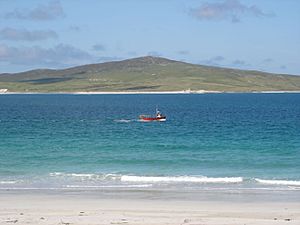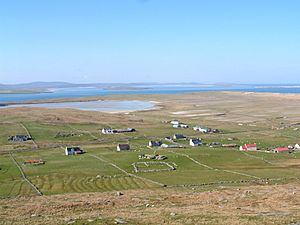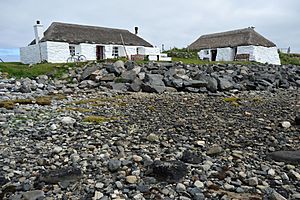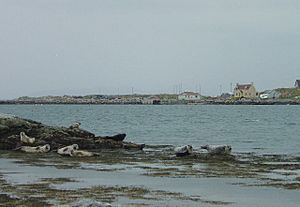Berneray (North Uist) facts for kids
| Gaelic name | Beàrnaraigh |
|---|---|
| Meaning of name | From Old Norse Bjorn's island |
| OS grid reference | NF912817 |
| Coordinates | 57°43′N 7°11′W / 57.72°N 7.19°W |
| Physical geography | |
| Island group | Uist and Barra |
| Area | 1,010 ha (2,496 acres) |
| Area rank | 50 |
| Highest elevation | Beinn Shleibhe (Moor Hill), 93 m (305 ft) |
| Administration | |
| Sovereign state | United Kingdom |
| Country | Scotland |
| Council area | Outer Hebrides |
| Demographics | |
| Population | 138 |
| Population density | 13.6/km2 (35/sq mi) |
| Largest settlement | Borve and Rushgarry |
Berneray (pronounced Bear-na-ray) is a small, beautiful island in Scotland, part of the Outer Hebrides. It's known for its amazing history and stunning natural beauty, which makes it a popular spot for visitors. Berneray is one of 15 islands in the Outer Hebrides where people live. It's also part of a special area called the South Lewis, Harris and North Uist National Scenic Area, which helps protect its incredible landscapes.
This island is about 10 square kilometers (or 3.9 square miles) in size. Its highest point is Beinn Shlèibhe (Moor Hill), which is about 93 meters (305 feet) tall. Berneray is famous for its long, sandy beaches with big sand dunes. One of the most loved beaches is Tràigh Iar (West Beach), a three-mile stretch of clean, quiet sand that many people say is one of the best.
People have lived on Berneray for a very long time, possibly since the Bronze Age. You can find ancient sacred places, stone circles, and signs that Vikings once lived here. There are also old buildings, some hundreds of years old, scattered across the island. Even though Berneray is closer to North Uist, it's actually part of the Harris area.
Contents
What's in a Name?
The name "Berneray" comes from an old language called Old Norse. It means "Bjorn's island," named after someone called Bjorn, or maybe even "bear island." For a long time, people who spoke Scottish Gaelic called it Beàrnaraigh na Hearadh, which means "Berneray of Harris". This helped tell it apart from another island called "Berneray of Barra Head." More recently, Gaelic speakers also call it Beàrnaraigh Uibhist, meaning "Berneray of Uist."
Who Lives on Berneray?
Like many islands in the Outer Hebrides, the number of people living on Berneray went down during the 1800s and 1900s. However, in recent years, the population has stayed steady. In 2011, there were 138 people living on the island, which was a small increase from 136 in 2001. Most people on Berneray speak Scottish Gaelic, and for many, it's their first language.
Life and Travel on Berneray
The main jobs on Berneray include fishing, crofting (a type of small-scale farming), working in media or IT, and tourism. In 2006, fast internet became available, which has helped people move to Berneray and keep the community strong.
A special part of Berneray is its machair. This is a flat, coastal area made from sand blown in by the wind, mixed with crushed seashells. Farmers here use old methods like adding seaweed and animal waste to the soil. This helps the land stay together and supports many different kinds of flowers. Berneray has a particularly beautiful machair because the farmers take such good care of it.
If you visit, you can stay at the youth hostel on Berneray. It's made of two old, restored traditional houses called "black houses." It has a wonderful view overlooking the Sound of Harris.
A big change for Berneray happened in 1999 when a causeway (a raised road over water) was built connecting it to North Uist. This made it much easier to travel to and from the island. It also helped people find jobs and made it quicker to transport goods like crabs and lobsters. The causeway was even opened by Prince Charles! This causeway is part of a series of roads that connect several islands in the area, making travel much simpler.
Berneray has regular local bus services from Lochmaddy on North Uist. You can also take a ferry, the MV Loch Portain, from Berneray to Harris. Another ferry, the MV Loch Bhrusda, is named after the biggest loch (lake) on Berneray.
Amazing Wildlife
The way farmers care for the land on Berneray also helps lots of different animals and birds. In early summer evenings, you might hear snipe birds making drumming sounds, or even the loud call of a corncrake. You can see mute swans on Loch Brusda, and many greylag geese. In winter, other geese like barnacle geese join them.
You'll often spot Ravens and buzzards flying overhead. Rarer birds like Golden eagles and hen harriers can sometimes be seen in winter. Near the shore, you might find wading birds like redshanks, sanderlings, turnstones, oyster catchers, and curlews.
Out in the sea around Berneray, there are mallards, eiders, and red-breasted mergansers. Sometimes, you can even see black-throated and great northern divers. Shags and cormorants fish in the waters all year. In summer, look for gannets diving into the sea.
Common seals often gather on the rocks in Bays Loch when the tide is low. You can often see them from a special viewing spot. Grey seals, which are bigger and have longer noses, also visit sometimes, but they are more common off West Beach. While otters on Berneray are sometimes seen during the day, they are still shy, so you need patience and luck to spot one!
Berneray in Media and Arts
Berneray has been featured in several films and songs.
- A documentary called Shepherds of Berneray was shown on TV in the UK in 1981.
- In 1987, Berneray was in the news when Charles, Prince of Wales (now King Charles III) visited the island to experience life as a crofter. He lived and worked with a local farmer for a week. This visit led to a TV documentary in 1991 called A Prince Among Islands.
- In 2007, a DVD was released about the island's special New Year's Eve celebration, which used to happen on January 12th, following an older calendar.
- In 2009, it was reported that Berneray's west beach was used in an advertisement for a beach in Thailand! People thought it was a compliment to Berneray's beauty.
- The traditional Gaelic song 'Fàgail Bheàrnaraigh' (Leaving Berneray) later became a famous American folk song called "O, Waly, Waly' The Water is Wide."
- The English singer Vashti Bunyan wrote much of her first album while living in a croft on Berneray.
Famous People from Berneray
- Berneray is the birthplace of Angus MacAskill, who was known as a giant because of his incredible height.
- Iain Eairdsidh MacAsgaill, a soldier from World War I and a famous poet who wrote in Scottish Gaelic, was born and grew up on Berneray.
- Donald MacKillop (1926 - 2015), a songwriter and poet important in Scottish Gaelic literature, was also from Berneray.
- Fish (singer) (born 1958), a Scottish writer, singer, and actor, owns a small farm on Berneray. He has shared plans to move there permanently when he retires from music.






